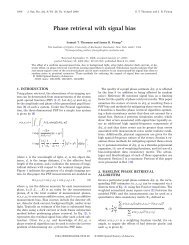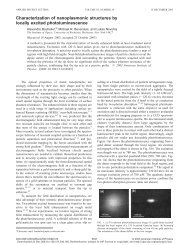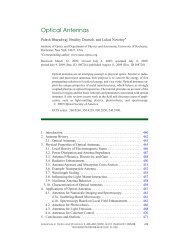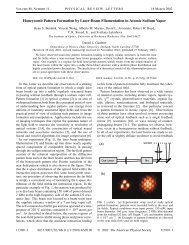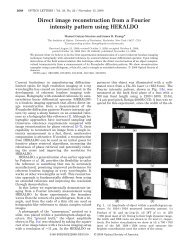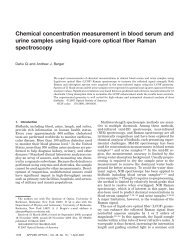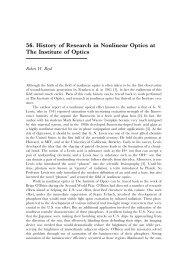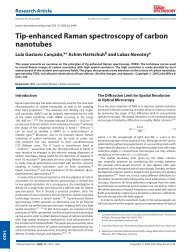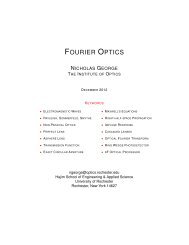Nonlinear effects in Silicon Waveguides - The Institute of Optics ...
Nonlinear effects in Silicon Waveguides - The Institute of Optics ...
Nonlinear effects in Silicon Waveguides - The Institute of Optics ...
Create successful ePaper yourself
Turn your PDF publications into a flip-book with our unique Google optimized e-Paper software.
1/56<br />
<strong>Nonl<strong>in</strong>ear</strong> <strong>effects</strong> <strong>in</strong> <strong>Silicon</strong> <strong>Waveguides</strong><br />
Gov<strong>in</strong>d P. Agrawal<br />
<strong>Institute</strong> <strong>of</strong> <strong>Optics</strong><br />
University <strong>of</strong> Rochester<br />
Rochester, NY 14627<br />
c○2007 G. P. Agrawal<br />
◭◭<br />
◮◮<br />
◭<br />
◮<br />
Back<br />
Close
Outl<strong>in</strong>e<br />
• Why use silicon for photonics?<br />
• <strong>Silicon</strong>-on-Insulator (SOI) <strong>Waveguides</strong><br />
2/56<br />
• Two-Photon Absorption and Free-Carrier Effects<br />
• Self-Phase Modulation and Soliton Formation<br />
• Higher-Order Solitons and Supercont<strong>in</strong>uum Generation<br />
• Cross-Phase Modulation and Optical Switch<strong>in</strong>g<br />
• Four-Wave Mix<strong>in</strong>g and Parametric Amplification<br />
• Raman Amplification and <strong>Silicon</strong> Raman Lasers<br />
• Conclud<strong>in</strong>g Remarks<br />
◭◭<br />
◮◮<br />
◭<br />
◮<br />
Back<br />
Close
<strong>Silicon</strong> Photonics<br />
• <strong>Silicon</strong> dom<strong>in</strong>ates microelectronics <strong>in</strong>dustry totally.<br />
• <strong>Silicon</strong> photonics is a new research area try<strong>in</strong>g to capitalize on the<br />
huge <strong>in</strong>vestment by the microelectronics <strong>in</strong>dustry.<br />
3/56<br />
• It has the potential for provid<strong>in</strong>g a monolithically <strong>in</strong>tegrated<br />
optoelectronic platform on a silicon chip.<br />
Credit:<br />
Intel and IBM Websites<br />
◭◭<br />
◮◮<br />
◭<br />
◮<br />
Back<br />
Close
<strong>Silicon</strong>-on-Insulator Technology<br />
4/56<br />
• Core waveguide layer is made <strong>of</strong> silicon (n 1 = 3.45).<br />
• A silica layer under the core layer is used for lower cladd<strong>in</strong>g.<br />
• Silica layer formed by implant<strong>in</strong>g oxygen, followed with anneal<strong>in</strong>g.<br />
• A rib or ridge structure used for two-dimensional conf<strong>in</strong>ement.<br />
• Air on top conf<strong>in</strong>es mode tightly (large <strong>in</strong>dex difference).<br />
◭◭<br />
◮◮<br />
◭<br />
◮<br />
Back<br />
Close
SOI Waveguide Geometry<br />
[0 0 1]<br />
5/56<br />
[1 1 0]<br />
• SEM image <strong>of</strong> an SOI device;<br />
Izhaky et al., JSTQE, (2006).<br />
• Typically W ∼ 1 µm,<br />
H ∼ 1 µm, h ∼ H/2.<br />
• Dispersion normal at telecom<br />
wavelengths (λ 0 ∼ 2.2 µm).<br />
◭◭<br />
◮◮<br />
◭<br />
◮<br />
Back<br />
Close
Waveguide Dispersion<br />
• Mode <strong>in</strong>dex ¯n(ω) = n 1 (ω) − δn W (ω).<br />
• Material dispersion results from n 1 (ω) (<strong>in</strong>dex <strong>of</strong> silicon).<br />
6/56<br />
• Waveguide dispersion results from δn W (ω).<br />
• Total dispersion D = D M + D W can be controlled.<br />
◭◭<br />
◮◮<br />
◭<br />
◮<br />
Back<br />
Close
Major <strong>Nonl<strong>in</strong>ear</strong> Effects<br />
• Self-Phase Modulation (SPM)<br />
• Cross-Phase Modulation (XPM)<br />
7/56<br />
• Four-Wave Mix<strong>in</strong>g (FWM)<br />
• Stimulated Brillou<strong>in</strong> Scatter<strong>in</strong>g (SBS)<br />
• Stimulated Raman Scatter<strong>in</strong>g (SRS)<br />
Orig<strong>in</strong> <strong>of</strong> <strong>Nonl<strong>in</strong>ear</strong> Effects <strong>in</strong> <strong>Silicon</strong><br />
• Third-order nonl<strong>in</strong>ear susceptibility χ (3) .<br />
• Real part leads to SPM, XPM, and FWM.<br />
• Imag<strong>in</strong>ary part leads to two-photon absorption (TPA).<br />
◭◭<br />
◮◮<br />
◭<br />
◮<br />
Back<br />
Close
Third-order <strong>Nonl<strong>in</strong>ear</strong> Response<br />
˜P (3)<br />
i (ω i ) = 3ε ∫∫<br />
0<br />
16π 2<br />
χ (3)<br />
i jkl (−ω i;ω j ,−ω k ,ω l )Ẽ j (ω j )Ẽ ∗ k (ω k )Ẽ l (ω l )dω j dω k<br />
• Two dist<strong>in</strong>ct contributions from electronic and Raman responses:<br />
χ (3)<br />
i jkl = χe i jkl + χ R i jkl.<br />
• Electronic response for silicon is governed by<br />
χ e i jkl = χ e 1122δ i j δ kl + χ e 1212δ ik δ jl + χ e 1221δ il δ jk + χ e dδ i jkl .<br />
• Raman response for silicon is governed by<br />
χ R i jkl = χ R ˜H R (ω l − ω k )(δ ik δ jl + δ il δ jk − 2δ i jkl ) + a similar term.<br />
• A relatively narrow Lorentzian Raman-ga<strong>in</strong> spectrum:<br />
˜H R (Ω) =<br />
Ω 2 R<br />
Ω 2 R − Ω2 − 2iΓ R Ω<br />
(<br />
ΩR<br />
2π = 15.6 THz, Γ R<br />
π = 105 GHz )<br />
.<br />
8/56<br />
◭◭<br />
◮◮<br />
◭<br />
◮<br />
Back<br />
Close
Third-order <strong>Nonl<strong>in</strong>ear</strong> Susceptibility<br />
• <strong>The</strong> tensorial nature <strong>of</strong> χ (3) makes theory quite complicated.<br />
• It can be simplified considerably when a s<strong>in</strong>gle optical beam excites<br />
the fundamental TE or TM mode <strong>of</strong> the Si waveguide.<br />
9/56<br />
• Only the component χ1111 e (−ω;ω,−ω,ω) is relevant <strong>in</strong> this case.<br />
• Its real and imag<strong>in</strong>ary part the Kerr coefficient n 2 and the TPA<br />
coefficient β T as<br />
ω<br />
c n 2(ω) + i 2 β TPA(ω) =<br />
3ω<br />
4ε 0 c 2 n 2 χ1111(−ω;ω,−ω,ω).<br />
e<br />
0<br />
• A recent review provides more details:<br />
Q. L<strong>in</strong>, O. J. Pa<strong>in</strong>ter, G. P. Agrawal, Opt. Express 15, 16604 (2007).<br />
◭◭<br />
◮◮<br />
◭<br />
◮<br />
Back<br />
Close
Measured <strong>Nonl<strong>in</strong>ear</strong> Parameters<br />
4<br />
3<br />
0.7<br />
0.6<br />
0.5<br />
10/56<br />
2<br />
0.4<br />
0.3<br />
1<br />
0.2<br />
0.1<br />
0<br />
1200 1400 1600 1800 2000 2200 2400<br />
0.0<br />
1200 1400 1600 1800 2000 2200 2400<br />
L<strong>in</strong> et al, Appl. Phys. Lett. 91, 021111 (2007)<br />
• We measured n 2 and β TPA for silicon <strong>in</strong> the spectral range <strong>of</strong> 1.2 to<br />
2.4 µm us<strong>in</strong>g the z scan technique.<br />
• n 2 larger for silicon by >100 compared with silica fibers.<br />
• As expected, β TPA vanishes for λ > 2.2 µm<br />
◭◭<br />
◮◮<br />
◭<br />
◮<br />
Back<br />
Close
<strong>Nonl<strong>in</strong>ear</strong> Parameters<br />
• Refractive <strong>in</strong>dex depends on <strong>in</strong>tensity as (Kerr effect):<br />
n(ω,I) = ¯n(ω) + n 2 (1 + ir)I(t).<br />
11/56<br />
• Material parameter n 2 = 3 × 10 −18 m 2 /W is larger for silicon by a<br />
factor <strong>of</strong> 100 compared with silica fibers.<br />
• Dimensionless parameter r = β TPA /(2k 0 n 2 ) is related to two-photon<br />
absorption (TPA) occurr<strong>in</strong>g when hν exceeds E g /2.<br />
• TPA parameter: β TPA = 5×10 −12 m/W at wavelengths near 1550 nm.<br />
• Dimensionless parameter r ≈ 0.1 for silicon near 1550 nm.<br />
• TPA is a major limit<strong>in</strong>g factor for SOI waveguides because it creates<br />
free carriers (<strong>in</strong> addition to nonl<strong>in</strong>ear losses).<br />
◭◭<br />
◮◮<br />
◭<br />
◮<br />
Back<br />
Close
Free-Carrier Generation<br />
• TPA creates free carriers <strong>in</strong>side a silicon waveguide accord<strong>in</strong>g to<br />
∂N c<br />
∂t<br />
= β TPA<br />
2hν 0<br />
I 2 (z,t) − N c<br />
τ c<br />
.<br />
12/56<br />
• Carrier lifetime is relatively large for silicon (τ c > 10 ns).<br />
• It limits the device response time if carriers cannot be removed<br />
quickly enough.<br />
• Free carriers also <strong>in</strong>troduce loss and change the refractive <strong>in</strong>dex.<br />
• Pulse propagation <strong>in</strong>side silicon waveguides is governed by<br />
∂A<br />
∂z + iβ 2 ∂ 2 A<br />
2 ∂t = ik 0n 2 2 (1 + ir)|A| 2 A − σ 2 (1 + iµ)N cA − α l<br />
2 A.<br />
◭◭<br />
◮◮<br />
◭<br />
◮<br />
Back<br />
Close
Free-Carrier Absorption (FCA)<br />
• Loss <strong>in</strong>duced by FCA: α f = σN c with σ = 1.45 × 10 −21 m 2 .<br />
13/56<br />
• Free carriers also change the refractive <strong>in</strong>dex by ∆n = −(µ/2k 0 )σN c<br />
(free-carrier dispersion).<br />
• This change is opposite to the <strong>in</strong>dex change n 2 I result<strong>in</strong>g from the<br />
Kerr effect.<br />
• Parameter µ is known as the “l<strong>in</strong>ewidth enhancement factor” <strong>in</strong> the<br />
context <strong>of</strong> semiconductor lasers.<br />
• Its value for silicon is close to 7.5 <strong>in</strong> the spectral region near 1550 nm.<br />
• Absorption and <strong>in</strong>dex changes result<strong>in</strong>g from free carriers affect the<br />
performance <strong>of</strong> silicon waveguides.<br />
• Quick removal <strong>of</strong> carriers helps (e.g., by apply<strong>in</strong>g a dc electric field).<br />
◭◭<br />
◮◮<br />
◭<br />
◮<br />
Back<br />
Close
Removal <strong>of</strong> Free Carriers<br />
14/56<br />
Jones et al, Opt. Exp. 13, 519 (2005)<br />
• A reversed-biased p-n junction is used for this purpose.<br />
• Electric field across the waveguide removes electrons and holes.<br />
• Drift time becomes shorter for larger applied voltages.<br />
• Effective carrier lifetime can be shortened from >20 to
Self-Phase Modulation (SPM)<br />
• Refractive <strong>in</strong>dex depends on <strong>in</strong>tensity as n ′ = ¯n + n 2 I(t).<br />
• Propagation constant also becomes <strong>in</strong>tensity-dependent:<br />
15/56<br />
β ′ = β + k 0 n 2 (P/A eff ) ≡ β + γP.<br />
• <strong>Nonl<strong>in</strong>ear</strong> parameter γ = k 0 n 2 /A eff can be larger by a factor <strong>of</strong><br />
10,000 compared with silica fibers.<br />
• <strong>Nonl<strong>in</strong>ear</strong> Phase shift:<br />
φ NL =<br />
∫ L<br />
0<br />
(β ′ − β)dz =<br />
∫ L<br />
Here, P(z) = P <strong>in</strong> e −αz and L eff = (1 − e −αL )/α.<br />
• Optical field modifies its own phase (SPM).<br />
0<br />
γP(z)dz = γP <strong>in</strong> L eff .<br />
• Phase shift varies with time for pulses (chirp<strong>in</strong>g).<br />
◭◭<br />
◮◮<br />
◭<br />
◮<br />
Back<br />
Close
Chirp<strong>in</strong>g and Spectral Broaden<strong>in</strong>g<br />
1<br />
0.8<br />
(a)<br />
2<br />
1<br />
(b)<br />
16/56<br />
Phase, φ NL<br />
0.6<br />
0.4<br />
Chirp, δωT 0<br />
0<br />
−1<br />
0.2<br />
0<br />
−2 −1 0 1 2<br />
−2<br />
−2 −1 0 1 2<br />
Time, T/T 0<br />
Time, T/T 0<br />
• In the case <strong>of</strong> optical pulses, φ NL (t) = γP(t)L eff .<br />
• Chirp is related to the phase derivative dφ NL /dt.<br />
• Phase and chirp pr<strong>of</strong>iles for super-Gaussian pulses are shown<br />
us<strong>in</strong>g P(t) = P 0 exp[−(t/T ) 2m ] with m = 1 and m = 3.<br />
• SPM creates new frequencies and leads to spectral broaden<strong>in</strong>g.<br />
◭◭<br />
◮◮<br />
◭<br />
◮<br />
Back<br />
Close
Self-Phase Modulation and TPA<br />
• Preced<strong>in</strong>g analysis neglected two-photon absorption.<br />
• Its impact on SPM can be studied by solv<strong>in</strong>g:<br />
∂A<br />
∂z = iγ(1 + ir)|A|2 A − α l<br />
2 A.<br />
• This equation ignores dispersive and free-carrier <strong>effects</strong>.<br />
• Us<strong>in</strong>g A = √ Pexp(iφ NL ), we obta<strong>in</strong> the follow<strong>in</strong>g analytic solution:<br />
P(L,t) = P(0,t)exp(−α lL)<br />
1 + 2rγP(0,t)L eff<br />
,<br />
φ NL (L,t) = 1 2r ln[1 + 2rγP(0,t)L eff].<br />
• TPA converts l<strong>in</strong>ear dependence <strong>of</strong> φ NL on power to a logarithmic<br />
one.<br />
17/56<br />
◭◭<br />
◮◮<br />
◭<br />
◮<br />
Back<br />
Close
Impact <strong>of</strong> Two-Photon Absorption<br />
• TPA reduces the maximum<br />
phase shift:<br />
φ 0 = ln(1 + 2rφ max )/(2r).<br />
• In the absence <strong>of</strong> TPA,<br />
φ 0 = φ max = γP 0 L eff .<br />
nonl<strong>in</strong>ear phase shift φ 0<br />
/ π<br />
3<br />
2.5<br />
2<br />
1.5<br />
1<br />
φ max<br />
= 3π<br />
φ max<br />
= 2π<br />
φ max<br />
= π<br />
• Inset shows the reduction<br />
0.5<br />
us<strong>in</strong>g r = 0.1. 0 0.2 0.4 0.6 0.8 1<br />
β TPA<br />
/(k 0<br />
n 2<br />
)<br />
• TPA-<strong>in</strong>duced reduction becomes severe at high powers.<br />
• When φ max = 100, φ 0 is limited to a value <strong>of</strong> 15.<br />
φ 0<br />
/ π<br />
10<br />
8<br />
6<br />
4<br />
2<br />
0<br />
0 2 4 6 8 10<br />
φ max<br />
/ π<br />
18/56<br />
◭◭<br />
◮◮<br />
◭<br />
◮<br />
Back<br />
Close
Impact <strong>of</strong> Free-Carrier Generation<br />
Spectral density J/(cm 2 ⋅nm)<br />
Spectral density J/(cm 2 ⋅nm)<br />
φ max<br />
= 1.5π, I 0<br />
= 1.2 GW/cm 2 φ max<br />
= 7.5π, I 0<br />
= 6.0 GW/cm 2<br />
0.015 TPA=0<br />
TPA<br />
only<br />
0.025<br />
0.02<br />
0.01<br />
Full 0.015<br />
0.005<br />
0.01<br />
0.005<br />
0<br />
0<br />
1.549 1.5495 1.55 1.5505 1.551 1.548 1.55<br />
λ (µm)<br />
λ (µm)<br />
1.552<br />
0.015<br />
0.01<br />
0.005<br />
φ max<br />
= 15.5π, I 0<br />
= 12.5 GW/cm 2 φ max<br />
= 15.5π, I 0<br />
= 12.5 GW/cm 2<br />
TPA<br />
only<br />
TPA<br />
+FCA<br />
Full<br />
Phase shift φ / π<br />
0<br />
1.548 1.549 1.55 1.551 1.552<br />
λ (µm)<br />
4<br />
3<br />
2<br />
1<br />
0<br />
−1<br />
−2<br />
−3<br />
TPA<br />
+FCA<br />
TPA<br />
only<br />
Full<br />
−5 −4 −3 −2 −1 0 1 2 3 4 5<br />
t / T 0<br />
P(t) = P 0 e −t2 /T 2<br />
T 0 = 10 ps<br />
L = 2 cm<br />
τ c = 1 ns<br />
α l = 1 dB/cm<br />
Y<strong>in</strong> and Agrawal,<br />
Opt. Lett. (2007)<br />
Free carriers produce a nonl<strong>in</strong>ear phase shift <strong>in</strong> the opposite direction.<br />
19/56<br />
◭◭<br />
◮◮<br />
◭<br />
◮<br />
Back<br />
Close
Experimental Results<br />
20/56<br />
Boyraz et al., Opt. Exp. 12, 829 (2004).<br />
• First observation <strong>of</strong> SPM-<strong>in</strong>duced spectral broaden<strong>in</strong>g <strong>in</strong> 2004.<br />
• 4-ps pulses launched <strong>in</strong>side a 2-cm-long SOI waveguide.<br />
• <strong>The</strong> 3-peak output spectrum broadened by a factor <strong>of</strong> 2 when peak<br />
<strong>in</strong>tensity was 2.2 GW/cm 2 (P 0 ≈ 100 W).<br />
◭◭<br />
◮◮<br />
◭<br />
◮<br />
Back<br />
Close
itted <strong>in</strong>tensity but not <strong>in</strong> spectral shape and position. <strong>The</strong> spectral full width at half<br />
(FWHM) is identical to pulses measured without sample. Hence, the applied<br />
the two low-power spectra belong to the regime where the waveguide is respond<strong>in</strong>g<br />
<strong>in</strong>ear. However, by <strong>in</strong>creas<strong>in</strong>g the peak power to P = 1.55 W (I ≈ 2.6 GW/cm 2 ), the<br />
ape <strong>of</strong> the pulses broadens dramatically; now exhibit<strong>in</strong>g several spectral side w<strong>in</strong>gs.<br />
en<strong>in</strong>g Experimental cont<strong>in</strong>ues for higher powers which Results can be seen <strong>in</strong> the spectrum with P = 6.85<br />
6 GW/cm 2 ).<br />
-70<br />
Transmission (dBm)<br />
-75<br />
-80<br />
-85<br />
-90<br />
-95<br />
-100<br />
-105<br />
6.85 W<br />
1.55 W<br />
8 mW<br />
1.8 mW<br />
100 200 300 400<br />
1480 1500 1520<br />
Wavelength (nm)<br />
Fig. 1. Transmission spectra <strong>of</strong> a 4 mm long SOI waveguide as a function <strong>of</strong> coupled peak<br />
power. L<strong>in</strong>ear optical response is observed for low powers (black and red) whereas SPM<strong>in</strong>duced<br />
spectral<br />
Dulkeith<br />
broaden<strong>in</strong>g<br />
et<br />
occurs<br />
al.,<br />
for<br />
Opt.<br />
high powers<br />
Exp.<br />
(green<br />
14,<br />
and<br />
5524<br />
blue). Inset: Time- and<br />
spectrally resolved FROG trace <strong>of</strong> <strong>in</strong>put pulses at 1500 nm.<br />
(2006).<br />
easured spectral pulse distortions can be expla<strong>in</strong>ed by self-phase-modulation,<br />
nown to cause an <strong>in</strong>tensity dependent phase shift <strong>of</strong> the pulse carrier frequency.<br />
own duration, the pulse experiences an <strong>in</strong>tensity- and thus time-dependent<br />
<strong>in</strong>dex. New frequency components are generated and the <strong>in</strong>itial pulse spectrum<br />
100<br />
200<br />
300<br />
400<br />
500<br />
600<br />
53.2<br />
49.9<br />
43.6<br />
37.4<br />
31.2<br />
24.9<br />
18.7<br />
12.5<br />
6.23<br />
0<br />
• Larger broaden<strong>in</strong>g by 2006.<br />
• 1.8-ps pulses launched<br />
<strong>in</strong>side a 4-mm-long<br />
waveguide.<br />
• Width 470 nm<br />
height 226 nm.<br />
• Spectral asymmetry is due<br />
to free-carrier <strong>effects</strong>.<br />
• Inset shows the FROG<br />
trace.<br />
21/56<br />
◭◭<br />
◮◮<br />
◭<br />
◮<br />
Back<br />
Close
e broadened and asymmetric. <strong>The</strong> significant difference is that SPM-<strong>in</strong>duced<br />
g becomes more efficient for longer wavelengths. <strong>The</strong> spectral distance between the<br />
length SPM oscillation and the orig<strong>in</strong>ally <strong>in</strong>jected laser wavelength <strong>in</strong>creases from<br />
when the OPA is tuned from 1400 to 1650 nm. As will be discussed <strong>in</strong> the next<br />
is enhancement for longer wavelengths is probably due to an <strong>in</strong>crease <strong>of</strong> group<br />
d nonl<strong>in</strong>ear<br />
Wavelength<br />
refractive <strong>in</strong>dex n 2 .<br />
Dependence <strong>of</strong> SPM<br />
Transmission (dB)<br />
-75<br />
-80<br />
-85<br />
-90<br />
-95<br />
-100<br />
-105<br />
1400 1450 1500 1550 1600 1650<br />
Wavelength (nm)<br />
Fig. 4. SPM-<strong>in</strong>duced spectral broaden<strong>in</strong>g <strong>of</strong> optical pulses for the same coupled<br />
peak power (6.85 W) <strong>in</strong>jected <strong>in</strong>to the SOI waveguide at 1400, 1500 and 1600 nm.<br />
<strong>The</strong> spectral Dulkeith broaden<strong>in</strong>g et<strong>in</strong>creases al., with Opt. the wavelength. Exp. 14, 5524<br />
(2006).<br />
Experimental Results agree with theoretical predictions.<br />
• SPM-broadened spectra at<br />
three different wavelengths.<br />
• 1.8-ps pulses tunable from<br />
1400 to 1650 nm.<br />
• Larger broaden<strong>in</strong>g at longer<br />
wavelengths.<br />
• Consistent with a larger n 2<br />
near 1550 nm<br />
rison with theory and discussion<br />
description<br />
e the experimental data we have used a recently developed theoretical model to<br />
e pulse dynamics <strong>in</strong> Si photonic wires. It accounts for GVD, parametric and nonnonl<strong>in</strong>ear<br />
<strong>effects</strong> such as SPM, XPM, TPA, or Raman <strong>in</strong>teraction; free carrier-<br />
22/56<br />
◭◭<br />
◮◮<br />
◭<br />
◮<br />
Back<br />
Close
Formation <strong>of</strong> Optical Solitons<br />
• SPM-<strong>in</strong>duced phase shift φ NL > 1 is easily realized.<br />
• φ NL = 1 occurs at z = L NL = 1/(γP 0 ).<br />
• <strong>Nonl<strong>in</strong>ear</strong> length L NL ∼1 cm at moderate peak powers
Formation <strong>of</strong> Optical Solitons<br />
Normalized P ower<br />
S pectral Density<br />
1<br />
0.8<br />
0.6<br />
0.4<br />
0.2<br />
P ulse S hape<br />
0<br />
500 400 300 200 100 0 100 200 300 400 500<br />
time (fs)<br />
P ulse S pectrum<br />
1<br />
0.8<br />
0.6<br />
0.4<br />
0.2<br />
P ath averaged<br />
T P A<br />
P ath averaged<br />
Input<br />
Input<br />
0<br />
1.51 1.52 1.53 1.54 1.55 1.56 1.57 1.58 1.59<br />
Wavelength (µm)<br />
Y<strong>in</strong>, L<strong>in</strong>, and Agrawal, Opt. Lett. 31, 1295 (2006)<br />
130-fs pulses launched <strong>in</strong>side a 5-mm-long waveguide (N = 1).<br />
T P A<br />
α<br />
24/56<br />
◭◭<br />
◮◮<br />
◭<br />
◮<br />
Back<br />
Close
Path-Averaged Solitons<br />
• Perfect solitons do not for <strong>in</strong>side silicon waveguides.<br />
• L<strong>in</strong>ear and nonl<strong>in</strong>ear (TPA) losses broaden the pulse as N = 1 is<br />
not ma<strong>in</strong>ta<strong>in</strong>ed along the whole device.<br />
25/56<br />
• Concept <strong>of</strong> path-averaged solitons can be used to reduce<br />
pulse broaden<strong>in</strong>g.<br />
• Input peak power <strong>in</strong>creased such that N = 1 on average.<br />
• Required peak power is estimated us<strong>in</strong>g<br />
¯P 0 = 1 L<br />
∫ L<br />
0<br />
P 0 (z)dz = 1<br />
γL D<br />
.<br />
• Solion formation has been observed <strong>in</strong> a recent experiment.<br />
◭◭<br />
◮◮<br />
◭<br />
◮<br />
Back<br />
Close
Observation <strong>of</strong> Optical Solitons<br />
26/56<br />
• In a 2007 experiment, Zhang et al. [Opt. Exp. 15, 7682 (2007)]<br />
launched 110-fs Gaussian pulses <strong>in</strong>side a 5-mm-long waveguide.<br />
• Gaussian spectrum broadened at 1250 nm because <strong>of</strong> β 2 > 0.<br />
• It narrowed and acquired a “sech” shape at 1484 nm where β 2 < 0.<br />
◭◭<br />
◮◮<br />
◭<br />
◮<br />
Back<br />
Close
Numerical Simulations<br />
0<br />
0<br />
−5<br />
−5<br />
27/56<br />
−10<br />
−10<br />
Normalized Intensity (dB)<br />
−15<br />
−20<br />
−25<br />
Normalized Spectrum (dB)<br />
−15<br />
−20<br />
−25<br />
−30<br />
−30<br />
−35<br />
−35<br />
−40<br />
−8 −6 −4 −2 0 2 4 6 8<br />
Time τ/T 0<br />
• Numerical results under experimental conditions.<br />
−40<br />
1420 1440 1460 1480 1500 1520 1540<br />
Wavelength (nm)<br />
• Input: blue curves; Output: red curves; low power case (green).<br />
• Experimental data <strong>in</strong> agreement with numerical predictions.<br />
◭◭<br />
◮◮<br />
◭<br />
◮<br />
Back<br />
Close
Supercont<strong>in</strong>uum Generation<br />
• Ultrashort pulses are affected by a multitude <strong>of</strong> nonl<strong>in</strong>ear <strong>effects</strong>,<br />
such as SPM, XPM, FWM, and SRS, together with dispersion.<br />
• All <strong>of</strong> these nonl<strong>in</strong>ear processes are capable <strong>of</strong> generat<strong>in</strong>g new<br />
frequencies outside the <strong>in</strong>put pulse spectrum.<br />
• For sufficiently <strong>in</strong>tense pulses, the pulse spectrum can become so<br />
broad that it extends over a frequency range exceed<strong>in</strong>g 100 THz.<br />
• Such extreme spectral broaden<strong>in</strong>g is referred to as supercont<strong>in</strong>uum<br />
generation.<br />
• This phenomenon was first observed <strong>in</strong> solid and gases more than<br />
35 years ago (late 1960s.)<br />
• S<strong>in</strong>ce 2000, microstructure fibers have been used for supercont<strong>in</strong>uum<br />
generation.<br />
28/56<br />
◭◭<br />
◮◮<br />
◭<br />
◮<br />
Back<br />
Close
SC Generation <strong>in</strong> a microstructured fiber<br />
29/56<br />
Ranka et al., Opt. Lett. 25, 25 (2000)<br />
• Output spectrum generated <strong>in</strong> a 75-cm section <strong>of</strong> microstructured<br />
fiber us<strong>in</strong>g 100-fs pules with 0.8 pJ energy.<br />
• Even for such a short fiber, supercont<strong>in</strong>uum extends from<br />
400 to 1600 nm.<br />
• Supercont<strong>in</strong>uum is also relatively flat over the entire bandwidth.<br />
◭◭<br />
◮◮<br />
◭<br />
◮<br />
Back<br />
Close
SC Generation through Soliton Fission<br />
• Input pulses correspond to a higher-order soliton <strong>of</strong> large order;<br />
typically N = (γP 0 T 2<br />
0 /|β 2|) 1/2 exceeds 5.<br />
• Higher-order <strong>effects</strong> lead to their fission <strong>in</strong>to much narrower<br />
fundamental solitons: T k = T 0 /(2N + 1 − 2k).<br />
30/56<br />
• Each <strong>of</strong> these solitons is affected by <strong>in</strong>trapulse Raman scatter<strong>in</strong>g.<br />
• Spectrum <strong>of</strong> each soliton is shifted toward longer and longer wavelengths<br />
with propagation <strong>in</strong>side the fiber.<br />
• At the same time, each soliton emits nonsolitonic radiation at a<br />
different wavelength on the blue side.<br />
• XPM and FWM generate additional bandwidth and lead to a broad<br />
supercont<strong>in</strong>uum.<br />
◭◭<br />
◮◮<br />
◭<br />
◮<br />
Back<br />
Close
SC Generation <strong>in</strong> <strong>Silicon</strong> <strong>Waveguides</strong><br />
• SOI waveguides also support higher-order solitons when<br />
N = (γP 0 T 2<br />
0 /|β 2|) 1/2 exceeds 1.<br />
• Higher-order dispersion leads to their fission <strong>in</strong>to much<br />
shorter fundamental solitons: T k = T 0 /(2N + 1 − 2k).<br />
• Spectrum <strong>of</strong> each soliton shifts toward longer wavelengths by a<br />
smaller amount because <strong>of</strong> a narrower Raman-ga<strong>in</strong> spectrum <strong>of</strong> silicon.<br />
• Similar to the case <strong>of</strong> optical fibers, each soliton is expected to emit<br />
dispersive waves with frequencies on the blue side.<br />
• Numerical simulations confirm the potential <strong>of</strong> SOI waveguides for<br />
SC generation.<br />
• Spectral broaden<strong>in</strong>g over 350 nm is predicted for femtoseond pulses.<br />
31/56<br />
◭◭<br />
◮◮<br />
◭<br />
◮<br />
Back<br />
Close
Spectral and Temporal Evolution<br />
Normalized Power<br />
Normalized Power (dB)<br />
0.1<br />
0.05<br />
0<br />
−0.2 0 0.2 0.4 0.6 0.8<br />
time (ps)<br />
0<br />
−10<br />
−20<br />
Solitons<br />
Dispersive<br />
wave<br />
−30<br />
Cherenkov<br />
radiation<br />
Solitons<br />
−40<br />
1.2 1.3 1.4 1.5 1.6 1.7 1.8 1.9<br />
λ (µm)<br />
Y<strong>in</strong>, L<strong>in</strong>, and Agrawal, Opt. Lett. 32, 391 (2007)<br />
50-fs pulses launched with 25-W peak power <strong>in</strong>to a 1.2-cm waveguide.<br />
32/56<br />
◭◭<br />
◮◮<br />
◭<br />
◮<br />
Back<br />
Close
Impact <strong>of</strong> TPA on SC Generation<br />
Normalized Power (dB)<br />
0<br />
−10<br />
−20<br />
L=3 mm<br />
TPA=0<br />
−30<br />
L=3 mm<br />
with TPA<br />
−40<br />
1.2 1.3 1.4 1.5 1.6 1.7 1.8 1.9<br />
λ (µm)<br />
Y<strong>in</strong>, L<strong>in</strong>, and Agrawal, Opt. Lett. 32, 391 (2007)<br />
• TPA reduces SC bandwidth but is not detrimental.<br />
• Nearly 400-nm-wide supercont<strong>in</strong>uum created with<strong>in</strong><br />
a 3-mm-long waveguide.<br />
• Required pulse energies are relatively modest (∼1 pJ).<br />
33/56<br />
◭◭<br />
◮◮<br />
◭<br />
◮<br />
Back<br />
Close
Optical Switch<strong>in</strong>g<br />
34/56<br />
• A Mach-Zehnder <strong>in</strong>terferometer can be made us<strong>in</strong>g two Si waveguides.<br />
Such a device exhibits SPM-<strong>in</strong>duced optical switch<strong>in</strong>g.<br />
• In each arm, optical field accumulates l<strong>in</strong>ear and nonl<strong>in</strong>ear<br />
phase shifts.<br />
• Transmission through the bar port <strong>of</strong> the<strong>in</strong>terferometer:<br />
T = s<strong>in</strong> 2 (φ L + φ NL ); φ NL = (γP 0 /4)(L 1 − L 2 ).<br />
• T changes with <strong>in</strong>put power P 0 <strong>in</strong> a nonl<strong>in</strong>ear fashion.<br />
◭◭<br />
◮◮<br />
◭<br />
◮<br />
Back<br />
Close
Cross-Phase Modulation<br />
• Consider two optical fields propagat<strong>in</strong>g simultaneously.<br />
• <strong>Nonl<strong>in</strong>ear</strong> refractive <strong>in</strong>dex seen by one wave depends on the<br />
<strong>in</strong>tensity <strong>of</strong> the other wave as<br />
35/56<br />
∆n NL = n 2 (|A 1 | 2 + b|A 2 | 2 ).<br />
• Total nonl<strong>in</strong>ear phase shift <strong>in</strong> a fiber <strong>of</strong> length L:<br />
φ NL = (2πL/λ)n 2 [I 1 (t) + bI 2 (t)].<br />
• An optical beam modifies not only its own phase but also <strong>of</strong> other<br />
copropagat<strong>in</strong>g beams (XPM).<br />
• XPM <strong>in</strong>duces nonl<strong>in</strong>ear coupl<strong>in</strong>g among overlapp<strong>in</strong>g optical pulses.<br />
◭◭<br />
◮◮<br />
◭<br />
◮<br />
Back<br />
Close
XPM-Induced Spectral Changes<br />
36/56<br />
Hsieh et al., Opt. Exp. 15, 1135 (2007)<br />
• 200-fs pump and probe pulses (at 1527 and 1590 nm) launched <strong>in</strong>to<br />
a 4.7-mm-long SOI waveguide (w = 445 nm, h = 220 nm).<br />
• Pump and probe pulses travel at different speeds (walk-<strong>of</strong>f effect).<br />
• XPM-<strong>in</strong>duced phase shifts occurs as long as pulses overlap.<br />
• Asymmetric XPM-<strong>in</strong>duced spectral broaden<strong>in</strong>g depends on pump<br />
power (blue curve); Probe spectra without pump (red curve).<br />
◭◭<br />
◮◮<br />
◭<br />
◮<br />
Back<br />
Close
XPM-Induced Switch<strong>in</strong>g<br />
37/56<br />
• A Mach–Zehnder <strong>in</strong>terferometer is <strong>of</strong>ten used for optical switch<strong>in</strong>g.<br />
• Output switched to a different port us<strong>in</strong>g a control signal that shifts<br />
the phase through XPM.<br />
• If control signal is <strong>in</strong> the form <strong>of</strong> a pulse tra<strong>in</strong>, a CW signal can be<br />
converted <strong>in</strong>to a pulse tra<strong>in</strong>.<br />
• Turn-on time quite fast but the generation <strong>of</strong> free carriers widens<br />
the switch<strong>in</strong>g w<strong>in</strong>dow (depends on the carrier lifetime).<br />
◭◭<br />
◮◮<br />
◭<br />
◮<br />
Back<br />
Close
Experimental Demonstration<br />
38/56<br />
Boyraz et al., Opt. Exp. 12, 4094 (2004)<br />
• A Mach–Zehnder <strong>in</strong>terferometer used for optical switch<strong>in</strong>g.<br />
• Short pump pulses (
XPM-Induced Switch<strong>in</strong>g<br />
39/56<br />
Boyraz al., Opt. Exp. 12, 4094 (2004)<br />
• Instantaneous switch<strong>in</strong>g on the lead<strong>in</strong>g edge, as expected, with high<br />
on–<strong>of</strong>f contrast.<br />
• Long trail<strong>in</strong>g edge results from the free-carrier <strong>effects</strong>.<br />
• Free carriers provide an additional contribution to the probe phase<br />
by chang<strong>in</strong>g the refractive <strong>in</strong>dex.<br />
◭◭<br />
◮◮<br />
◭<br />
◮<br />
Back<br />
Close
Four-Wave Mix<strong>in</strong>g (FWM)<br />
40/56<br />
• FWM is a nonl<strong>in</strong>ear process that transfers energy from pumps<br />
to signal and idler waves.<br />
• FWM requires conservation <strong>of</strong><br />
⋆ Energy ω 1 + ω 2 = ω 3 + ω 4<br />
⋆ Momentum β 1 + β 2 = β 3 + β 4<br />
• Degenerate FWM: S<strong>in</strong>gle pump (ω 1 = ω 2 ).<br />
◭◭<br />
◮◮<br />
◭<br />
◮<br />
Back<br />
Close
Parametric Amplifiers<br />
• FWM can be used to amplify a weak signal.<br />
• Pump power is transferred to signal through FWM.<br />
• <strong>The</strong> idler (generated as a byproduct) acts as a copy <strong>of</strong> the signal at<br />
a new wavelength (useful for wavelength conversion).<br />
41/56<br />
• Parametric amplifiers can provide ga<strong>in</strong> at any wavelength us<strong>in</strong>g<br />
suitable pumps.<br />
• <strong>The</strong>y are also useful for all-optical signal process<strong>in</strong>g.<br />
• Optical fibers are <strong>of</strong>ten used, but the use <strong>of</strong> SOI waveguides would<br />
result <strong>in</strong> a much more compact device.<br />
• Impact <strong>of</strong> two-photon and free-carrier absorption requires further<br />
study.<br />
◭◭<br />
◮◮<br />
◭<br />
◮<br />
Back<br />
Close
FWM <strong>The</strong>ory for <strong>Silicon</strong> <strong>Waveguides</strong><br />
• <strong>The</strong>ory should <strong>in</strong>clude TPA and free-carrier <strong>effects</strong> fully.<br />
• Polarization and Raman <strong>effects</strong> should also be <strong>in</strong>cluded.<br />
• Full vector theory by L<strong>in</strong> et al., Opt. Exp. 14, 4786 (2006).<br />
• Free-carrier absorption limits the ga<strong>in</strong> for a CW pump.<br />
• β 2 < 0 (red); β 2 = 0 (blue); β 2 > 0 (green).<br />
42/56<br />
◭◭<br />
◮◮<br />
◭<br />
◮<br />
Back<br />
Close
FWM with Short Pump Pulses<br />
43/56<br />
L<strong>in</strong> et al., Opt. Exp. 14, 4786 (2006)<br />
• FCA is reduced significantly for pump pulses much shorter than<br />
carrier lifetime τ c .<br />
• Figure shows the case <strong>of</strong> 10-ps pump pulses with τ c = 1 ns.<br />
• Phase-match<strong>in</strong>g condition is satisfied even for signal that is shifted<br />
by 70 nm from the pump wavelength.<br />
◭◭<br />
◮◮<br />
◭<br />
◮<br />
Back<br />
Close
S<strong>in</strong>ge and Dual-Pump Configurations<br />
44/56<br />
L<strong>in</strong> et al., Opt. Exp. 14, 4786 (2006)<br />
• Parametric amplifiers with a large bandwidth can be realized by<br />
pump<strong>in</strong>g an SOI waveguide with two pumps.<br />
• This is possible because <strong>of</strong> a relatively short device length.<br />
• Recent experiments with SOI waveguides are encourag<strong>in</strong>g.<br />
◭◭<br />
◮◮<br />
◭<br />
◮<br />
Back<br />
Close
Experimental Results (S<strong>in</strong>gle Pump)<br />
45/56<br />
Foster et al., Nature 441, 760 (2006)<br />
• 3.5-ps pump pulses at 1550 nm; signal tunable over 80 nm.<br />
• Up to 5 dB <strong>of</strong> ga<strong>in</strong> observed <strong>in</strong> devices
Photon-Pair Generation<br />
46/56<br />
L<strong>in</strong> et al., Opt. Lett. 31, 3140 (2006)<br />
• Spontaneous FWM <strong>in</strong> fibers creates entangled photon pairs but<br />
suffers from the noise <strong>in</strong>duced by Raman scatter<strong>in</strong>g.<br />
• <strong>The</strong> use <strong>of</strong> SOI waveguides avoids this problem because Raman<br />
scatter<strong>in</strong>g does not occur when TM mode is excited.<br />
◭◭<br />
◮◮<br />
◭<br />
◮<br />
Back<br />
Close
Experimental Results<br />
47/56<br />
Sharp<strong>in</strong>g et al., Opt. Exp. 14, 12388 (2006)<br />
• 5-ps pump pulses launched <strong>in</strong>to a 9-mm-long SOI waveguide.<br />
• Total (red) and accidental (blue) co<strong>in</strong>cidence rates measured.<br />
• <strong>The</strong>ir ratio exceeded 10 at low pump powers.<br />
◭◭<br />
◮◮<br />
◭<br />
◮<br />
Back<br />
Close
Stimulated Raman Scatter<strong>in</strong>g<br />
• Scatter<strong>in</strong>g <strong>of</strong> a pump beam from vibrat<strong>in</strong>g molecules creates a<br />
Stokes beam down-shifted <strong>in</strong> frequency by a specific amount.<br />
48/56<br />
• Frequency shift is set by a vibrational mode (phonons).<br />
• Raman ga<strong>in</strong> spectrum exhibits a dom<strong>in</strong>ant peak at 15.6 THz with<br />
a 105-GHz bandwidth (≈1 nm wide near 1550 nm).<br />
• Peak ga<strong>in</strong> for silicon >1000 larger compared with silica.<br />
Claps et al., Opt. Exp.<br />
13, 2459 (2006)<br />
◭◭<br />
◮◮<br />
◭<br />
◮<br />
Back<br />
Close
Raman Amplifiers<br />
49/56<br />
Jalali et al., IEEE JSTQE 12, 412 (2006)<br />
• CW pump<strong>in</strong>g leads to accumulation <strong>of</strong> free carriers through TPA.<br />
• Free-carrier absorption <strong>in</strong>troduces losses for pump and signal.<br />
• No signal ga<strong>in</strong> occurs for τ eff > 10 ns.<br />
◭◭<br />
◮◮<br />
◭<br />
◮<br />
Back<br />
Close
Pulsed Raman Amplifiers<br />
50/56<br />
Jalali et al., IEEE JSTQE 12, 412 (2006)<br />
• Pulsed pump<strong>in</strong>g can provide >20-dB ga<strong>in</strong> if spac<strong>in</strong>g among pulses<br />
is much larger than τ eff (R p τ eff ≪ 1).<br />
• Free carriers can then decay before the next pulse arrives.<br />
• Pump pulses (∼30 ps) at 1540 used to amplify a 1673-nm signal.<br />
• 20-dB net ga<strong>in</strong> realized at 37-W peak power <strong>of</strong> pump pulses.<br />
◭◭<br />
◮◮<br />
◭<br />
◮<br />
Back<br />
Close
Raman Lasers<br />
51/56<br />
Boyraz and Jalali, Opt. Exp. 12, 5269 (2004)<br />
• Pumped with 30-ps pulses at 1540 nm at 25-MHz repetition rate.<br />
• Produced 18 ps pulses at 1675 nm at the same repetition rate.<br />
◭◭<br />
◮◮<br />
◭<br />
◮<br />
Back<br />
Close
CW Raman Amplifiers<br />
52/56<br />
Jones et al, Opt. Exp. 13, 519 (2005)<br />
• CW pump<strong>in</strong>g can be used if free carriers are removed quickly.<br />
• A reversed-biased p-n junction is used for this purpose.<br />
• Electric field across the waveguide removes electrons and holes.<br />
• Drift time <strong>of</strong> carriers is shorter for larger applied voltages.<br />
◭◭<br />
◮◮<br />
◭<br />
◮<br />
Back<br />
Close
CW Raman Amplifiers<br />
53/56<br />
Jones et al, Opt. Exp. 13, 519 (2005)<br />
• A 4.8-cm-long waveguide CW pumped at 1458 nm (signal at 1684 nm).<br />
• Output pump and signal powers <strong>in</strong>crease with applied voltage.<br />
• Effective carrier lifetime decreases from 16 to 1 ns.<br />
◭◭<br />
◮◮<br />
◭<br />
◮<br />
Back<br />
Close
<strong>The</strong>ory beh<strong>in</strong>d Raman Amplifiers and Lasers<br />
• Pump and signal powers satisfy the set <strong>of</strong> two coupled equations:<br />
∂P p<br />
∂z<br />
∂P s<br />
∂z<br />
= −(α lp + α fp )P p − β Tpp P 2 p − 2β Tps P s P p − g R P s P p<br />
= −(α ls + α fs )P s − β Tss P 2 s − 2β Tsp P p P s + g R P p P s .<br />
54/56<br />
• Signal loss α fs by free carriers (generated from the pump-<strong>in</strong>duced<br />
TPA) limit the performance severely.<br />
• For net amplification to occur, the carrier lifetime should satisfy<br />
τ 0 < τ th ≡ ¯hω pn s ā 2 pp(g R − 2β Tsp ) 2<br />
.<br />
2α ls σ as n 0s β Tpp ā 2 sp<br />
• A Raman laser cannot function if this condition does not hold.<br />
◭◭<br />
◮◮<br />
◭<br />
◮<br />
Back<br />
Close
Conclud<strong>in</strong>g Remarks<br />
• <strong>Nonl<strong>in</strong>ear</strong> <strong>effects</strong> <strong>in</strong> silicon waveguides can be used to make many<br />
active and passive components.<br />
55/56<br />
• SPM is useful for soliton formation and supercont<strong>in</strong>uum generation.<br />
• SPM and XPM can also be used for optical switch<strong>in</strong>g, wavelength<br />
conversion, and all-optical regeneration.<br />
• Four-wave mix<strong>in</strong>g converts silicon waveguides <strong>in</strong>to parametric<br />
amplifiers.<br />
• It can also be used for quantum applications requir<strong>in</strong>g entangled<br />
photon pairs.<br />
• Stimulated Raman scatter<strong>in</strong>g converts silicon waveguides <strong>in</strong>to<br />
Raman amplifiers.<br />
◭◭<br />
◮◮<br />
◭<br />
◮<br />
Back<br />
Close
Further Read<strong>in</strong>g<br />
• L. Pavesi and D. J. Lockwood, <strong>Silicon</strong> Photonics (Spr<strong>in</strong>ger, 2004).<br />
• G. T. Reed, <strong>Silicon</strong> Photonics: State <strong>of</strong> the Art (Wiley, 2007).<br />
56/56<br />
• IEEE J. Sel. Topics Quantum Electron., Special issue on <strong>Silicon</strong><br />
Photonics, 12 (2006).<br />
• B. Jalali and S. Fathpour, “<strong>Silicon</strong> Photonics,” J. Lightwave Technol.<br />
24, 4600 (2006).<br />
• B. Jalali, “Teach<strong>in</strong>g silicon new tricks,” Nature Photonics 1, 193<br />
(2007).<br />
• Q. L<strong>in</strong>, O. J. Pa<strong>in</strong>ter, G. P. Agrawal, “<strong>Nonl<strong>in</strong>ear</strong> optical phenomena<br />
<strong>in</strong> silicon waveguides,” Opt. Express 15, 16604 (2007).<br />
◭◭<br />
◮◮<br />
◭<br />
◮<br />
Back<br />
Close


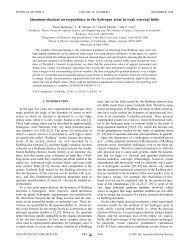
![Phase retrieval algorithms: a personal tour [Invited] - The Institute of ...](https://img.yumpu.com/25023725/1/190x249/phase-retrieval-algorithms-a-personal-tour-invited-the-institute-of-.jpg?quality=85)
